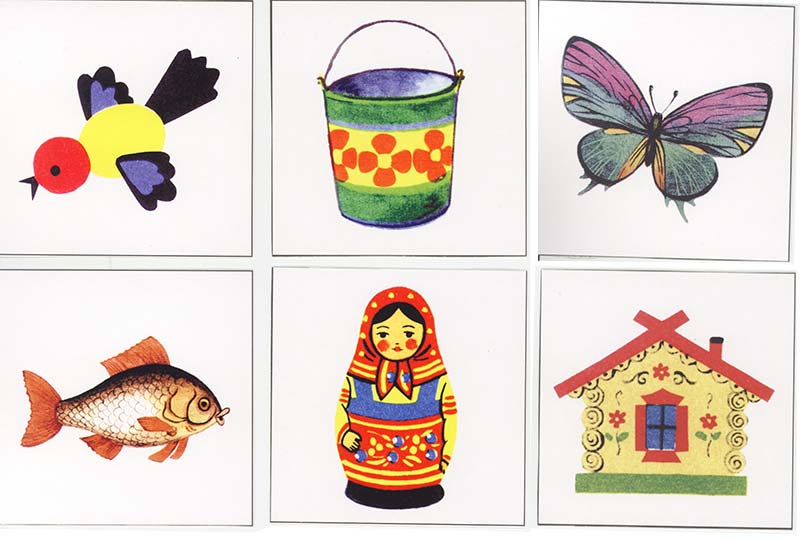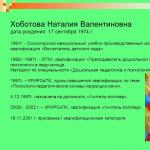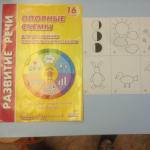Diagnostics of the development of children 3-4 years old
Diagnostics of the development of children 3-4 years old will help you independently assess the level of mental development of your child and find out what needs to be worked on. Diagnostics involves six small tests that will take you very little time. If the diagnostic results make you happy, then continue to deal with the child as you have it, your child has everything necessary for full development. If the diagnosis shows a low level of development of your child, then you should conduct a more in-depth diagnosis to determine the reasons for the low level of development of a particular mental process. In this case, it is better to contact a psychologist who will professionally conduct an in-depth diagnosis and give appropriate recommendations.
Target: assessment of the degree of formation of the perception of form and spatial relationships, the ability to analyze the location of figures in space.
Conduct procedure. Take a box with shaped slots and corresponding figures, which you will probably find among your child's toys. Place this box in front of the child. Give your child the inserts.
Instruction:“The figures live in this house. Each has its own door. Find a door for each figure."
Criteria for evaluation:
- The child performs the task on the basis of visual correlation - 2 points.
- The child often tries on, attaches the insert to a suitable slot and completes the task correctly - 1 point.
- The child did not cope with the task - 0 points.
Target: revealing the child's understanding of instructions, the formation of the concept of magnitude; assessment of the level of development of visual-effective thinking.
Conduct procedure. A child is shown a nesting doll, an adult takes it apart and then assembles it. After that, the matryoshka is placed in front of the child and they are asked to do the same. In addition, the child is asked to show the largest matryoshka, the smallest, put them in height.
Criteria for evaluation
- The child understands the instructions, disassembles and assembles the matryoshka by himself through trials - 2 points.
- The child copes with the task with the help of an adult - 1 point.

Target: assessment of the formation of visual-effective thinking, the degree of mastery of visual synthesis (combining elements into a holistic image).
Conduct procedure. Take a picture with a large image of an object familiar to the child, cut it into two parts, as shown in the figure. Lay out the parts so that they should not just be moved together, but given them the desired spatial position. The adult asks: “What do you think is drawn in this picture? What happens when you put the pieces together?"
After completing the task, the picture is removed and the child is offered to collect another picture, already cut into three parts.
Criteria for evaluation
- The child learned what is drawn in the picture, and correctly assembled the parts in both cases - 2 points.
- The child completed the task by trial - 1 point.
- The child makes pictures after numerous inadequate tests or does not cope with the task - 0 points.
Target: assessment of the ability to perceive colors, correlate them, find the same, knowledge of the names of colors, the ability to work according to oral instructions.
Conduct procedure. An adult and a child have the same set of colored cubes (blue, yellow, green, red).
- The adult takes one of the cubes and invites the child to show the same one. Similarly, tasks are performed with all the cubes.
- The child is offered to show a red cube, then blue, yellow, green.
- The adult takes the cubes one by one and asks what color they are.
Criteria for evaluation
- The child correctly shows and names the colors of the cubes - 2 points.
- The child correctly shows the cubes, but gets confused in the names of the colors - 1 point.
- The child does not cope with the task - 0 points.

Target: assessment of the ability to concentrate on presented objects, observation, visual memory.
Conduct procedure. Pictures (or objects) are laid out in front of the child. A similar set is found in an adult. The child is presented with pictures in turn, offered to find the same one and say what is shown on it.
Criteria for evaluation
- The child correctly said what is shown in the pictures and found the pairs - 2 points.
- The child correctly named 3-5 images, but had difficulty completing the task - 1 point.
- The child named less than three images in the pictures, could not match the pair - 0 points.
Target: assessment of the level of development of involuntary memory, understanding of instructions, attention.
Conduct procedure. Six toys are placed in front of the child and offered to name them, then the child closes his eyes, and the adult removes two toys: “Now the toys will play hide and seek with you. You close your eyes, and some toys will hide. When you open your eyes, you will have to say which toys are not there.
Criteria for evaluation
- The child remembered 2 toys - 2 points.
- The child remembered 1 toy - 1 point.
- The child did not name any hidden toys or did not understand the instructions - 0 points.
Evaluation of results
High level - 8 -12 points.
Average level - 5-7 points.
Low level - 0-4 points.






